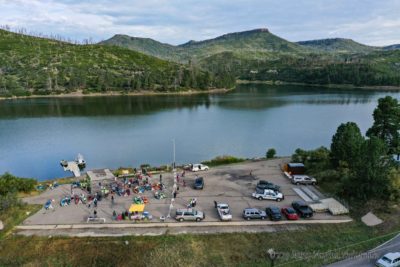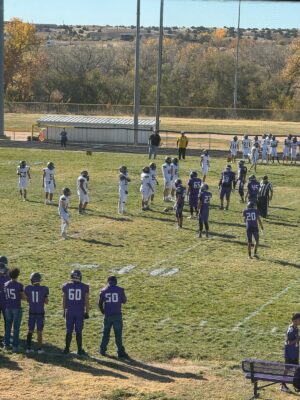The City of Raton has experienced city-wide power outages before lasting several hours, but never two days in a row as on Friday, June 9 and Saturday, June 10, 2023.
Multiple lightning strikes accompanied a severe thunderstorm cell on Friday afternoon, June 9 in the Burro Canyon substation area Northwest of Raton as power was knocked out at 1:02 pm and was restored at about 3:45 pm.
Then on June 10, a lightning arrestor inside the Burro Canyon substation failed and Raton again went off the grid from about 10:45 am until 3:30 pm.
Because of Raton Public Service Company’s inability to generate its own power, it must purchase power off the grid from Guzman Electric.
The last outage for multiple hours before that was on March 24, 2017. An early spring storm packing high winds and plenty of moisture, affected hundreds of travelers with closed roads and knocked out power to thousands of customers for both Raton Public Service Company and Springer Electric Cooperative on Friday, March 24th.
Marty Mayfield of KRTN did a series on electric generation/delivery for Raton and we go back in the archives to explain some of the challenges.
The power outages in Raton have caused concern especially since Raton Public Service used to produce its own electricity and now purchases power off the grid from Guzman Electric, with the transfer of assignment to Guzman Energy retroactive to February 8, 2019, Guzman took over the Raton portion of the agreement with Twin Eagle. Meaning that Guzman now purchases power from Twin Eagle and RPS will purchase power from Guzman.
How does the power get to Raton? The journey begins in Colorado near Pueblo where Excel Energy has a power plant and several large transmission lines tied together. The power Raton receives actually comes from that plant, however the way the electric grid is tied together at the power plant, some of it may come from other generating plants. But this is where the 69KV transmission power line feeding Raton electricity begins.
The 69KV transmission line that feeds Raton ties to the grid at the power plant substation and comes south, traveling east of I-25. It crosses I-25 just north of Walsenburg and ties in with the Walsenburg Sub Station located on the west side of town. This substation is maintained by Tri-State Generation. From there the transmission line once again crosses I-25 and works its way south before crossing the interstate south of Aguilar where it goes west up and over the hills to Burro Canyon where it ties in with the Burro Canyon Sub Station, this substation is also maintained by Tri-State.
Burro Canyon Substation does not have a full-time employee assigned to it, so if there is trouble, a technician must be dispatched which could take anywhere from 45 minutes to an hour before they arrive on scene.
The Burro Canyon substation feeds power up and down the Purgatoire River feeding San Isabel Electric customers as well as sending power on to Raton. The big transmission line leaves Burro Canyon and heads south up and over the hills some of which is very rugged terrain and finally comes down Dillon Canyon to the Raton Sub Station located on Gardner Road just west of Raton. From the Gardner Road Substation power is fed into the RPS substation at the power plant where eight different circuits feed power throughout Raton.
Springer Electric Coop also ties into this substation where they can feed RPS from the South and have done so in the past. Switch gear at the substation allows RPS to be switched to either the Burro Canyon line or Springer Electric Coop, but it is not as simple as just the flip of a switch. Before RPS can switch from the Burro Canyon line to Springer Electric several things must happen. First Tri-State Generation must be contacted where they then look at several factors including the electric load before the switch can be made. Springer Electric and RPS personnel must travel to the Raton Substation where electric meters are read and lines are isolated before throwing the switch in to tie Raton to Springer Electric. Once the long checklist has been completed and Tri-State gives the ok then the switch can be thrown to once again send power to RPS. At this point RPS who has opened all of their switches at the Plant substation to feed Raton begin the process of closing those switches to energize each circuit separately as not to overload the system and cause another power outage. Once the switches are closed Raton is once again in the light.
The outages not only are inconvenient for the general public, but have cost businesses thousands of dollars as gas pumps and cash registers all go dark.
An outage on March 24, 2017 that caused Raton to go dark for about eight hours was caused by a broken power pole on the 69KV transmission line from the Raton Substation to the RPS power plant substation in downtown Raton. Due to weather and ground conditions, it required a bulldozer to pull equipment in and out of the location where the pole was located which took several hours. Just to get the power back on RPS temporarily fixed the pole and then went back when conditions were more favorable to do a permanent repair on that pole.
Local business owners Mauricio Lemus and Mike Mulligan were present at a City Commission meeting after that 2017 outage to explain to commissioners the problems they had with the power outage. A letter from Lee Phelan indicated that McDonalds lost about $16,000 in revenue due to the outage while Mulligan told commissioners he lost about $8200. The biggest complaint however was the lack of communication about what was going on and when the power would be back on. The situation was also complicated by road closures of I-25 going over the pass and highway 64/87 to Clayton.
Prior to that there were two in 2015, one on May 25 and another on November 24th.





